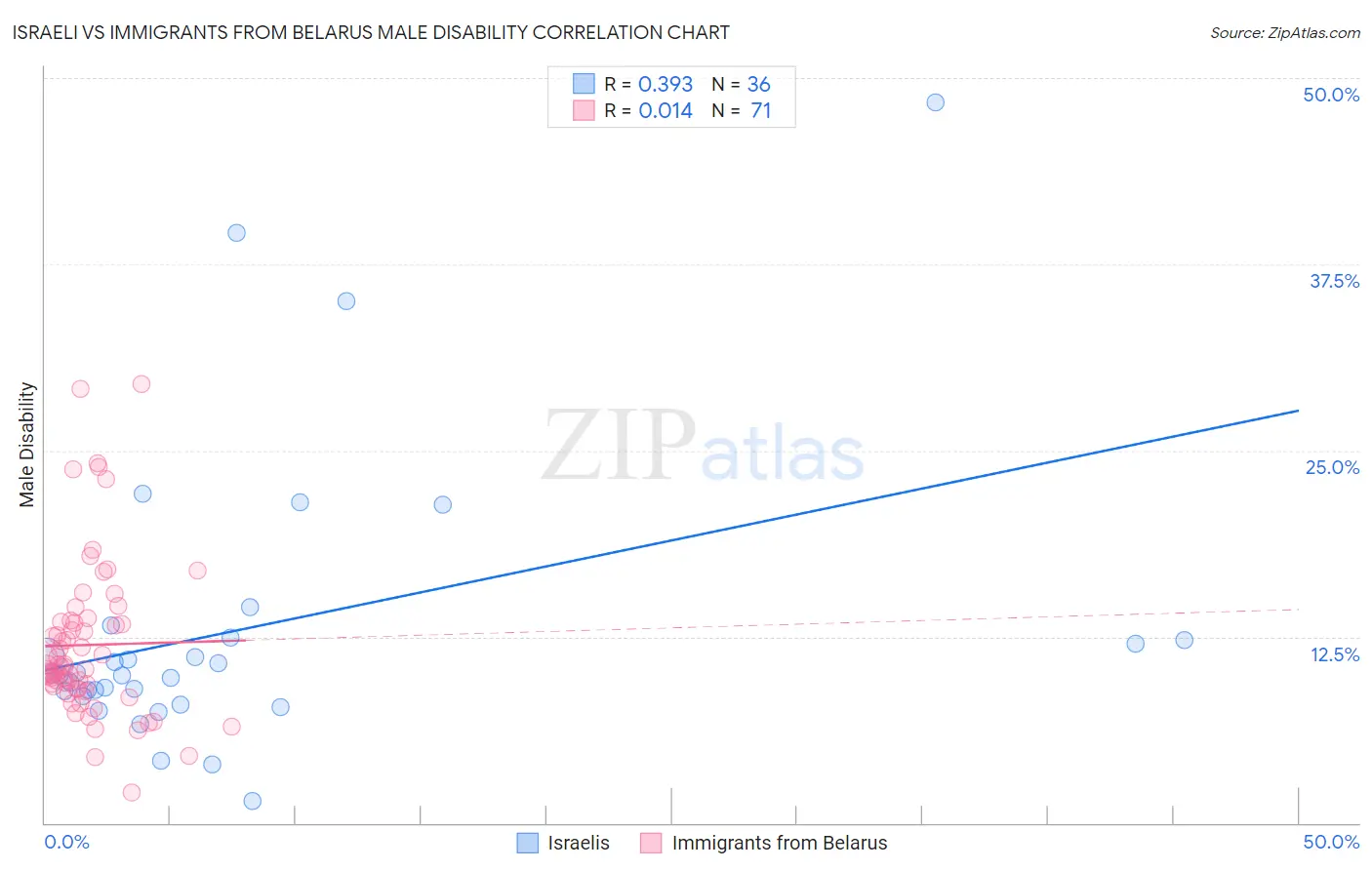Israeli vs Immigrants from Belarus Male Disability
COMPARE
Israeli
Immigrants from Belarus
Male Disability
Male Disability Comparison
Israelis
Immigrants from Belarus
10.3%
MALE DISABILITY
99.7/ 100
METRIC RATING
48th/ 347
METRIC RANK
10.4%
MALE DISABILITY
99.3/ 100
METRIC RATING
63rd/ 347
METRIC RANK
Israeli vs Immigrants from Belarus Male Disability Correlation Chart
The statistical analysis conducted on geographies consisting of 211,170,801 people shows a mild positive correlation between the proportion of Israelis and percentage of males with a disability in the United States with a correlation coefficient (R) of 0.393 and weighted average of 10.3%. Similarly, the statistical analysis conducted on geographies consisting of 150,193,333 people shows no correlation between the proportion of Immigrants from Belarus and percentage of males with a disability in the United States with a correlation coefficient (R) of 0.014 and weighted average of 10.4%, a difference of 1.2%.

Male Disability Correlation Summary
| Measurement | Israeli | Immigrants from Belarus |
| Minimum | 1.5% | 2.0% |
| Maximum | 48.4% | 29.5% |
| Range | 46.9% | 27.4% |
| Mean | 13.0% | 11.9% |
| Median | 10.0% | 10.5% |
| Interquartile 25% (IQ1) | 8.7% | 9.0% |
| Interquartile 75% (IQ3) | 12.4% | 13.5% |
| Interquartile Range (IQR) | 3.7% | 4.4% |
| Standard Deviation (Sample) | 9.7% | 5.3% |
| Standard Deviation (Population) | 9.6% | 5.2% |
Demographics Similar to Israelis and Immigrants from Belarus by Male Disability
In terms of male disability, the demographic groups most similar to Israelis are Immigrants from Peru (10.3%, a difference of 0.030%), Immigrants from Spain (10.3%, a difference of 0.060%), Cambodian (10.3%, a difference of 0.070%), Turkish (10.3%, a difference of 0.15%), and South American (10.3%, a difference of 0.19%). Similarly, the demographic groups most similar to Immigrants from Belarus are Immigrants from Ecuador (10.4%, a difference of 0.020%), Jordanian (10.5%, a difference of 0.12%), Immigrants from Grenada (10.5%, a difference of 0.15%), Immigrants from Northern Africa (10.4%, a difference of 0.29%), and Immigrants from Colombia (10.4%, a difference of 0.38%).
| Demographics | Rating | Rank | Male Disability |
| Turks | 99.7 /100 | #45 | Exceptional 10.3% |
| Cambodians | 99.7 /100 | #46 | Exceptional 10.3% |
| Immigrants | Peru | 99.7 /100 | #47 | Exceptional 10.3% |
| Israelis | 99.7 /100 | #48 | Exceptional 10.3% |
| Immigrants | Spain | 99.7 /100 | #49 | Exceptional 10.3% |
| South Americans | 99.6 /100 | #50 | Exceptional 10.3% |
| Salvadorans | 99.6 /100 | #51 | Exceptional 10.4% |
| Immigrants | Saudi Arabia | 99.6 /100 | #52 | Exceptional 10.4% |
| Immigrants | Uzbekistan | 99.6 /100 | #53 | Exceptional 10.4% |
| Peruvians | 99.6 /100 | #54 | Exceptional 10.4% |
| Immigrants | Eritrea | 99.6 /100 | #55 | Exceptional 10.4% |
| Tongans | 99.6 /100 | #56 | Exceptional 10.4% |
| Immigrants | South America | 99.6 /100 | #57 | Exceptional 10.4% |
| Immigrants | Japan | 99.5 /100 | #58 | Exceptional 10.4% |
| Immigrants | Australia | 99.5 /100 | #59 | Exceptional 10.4% |
| Immigrants | Colombia | 99.5 /100 | #60 | Exceptional 10.4% |
| Immigrants | Northern Africa | 99.4 /100 | #61 | Exceptional 10.4% |
| Immigrants | Ecuador | 99.3 /100 | #62 | Exceptional 10.4% |
| Immigrants | Belarus | 99.3 /100 | #63 | Exceptional 10.4% |
| Jordanians | 99.3 /100 | #64 | Exceptional 10.5% |
| Immigrants | Grenada | 99.2 /100 | #65 | Exceptional 10.5% |